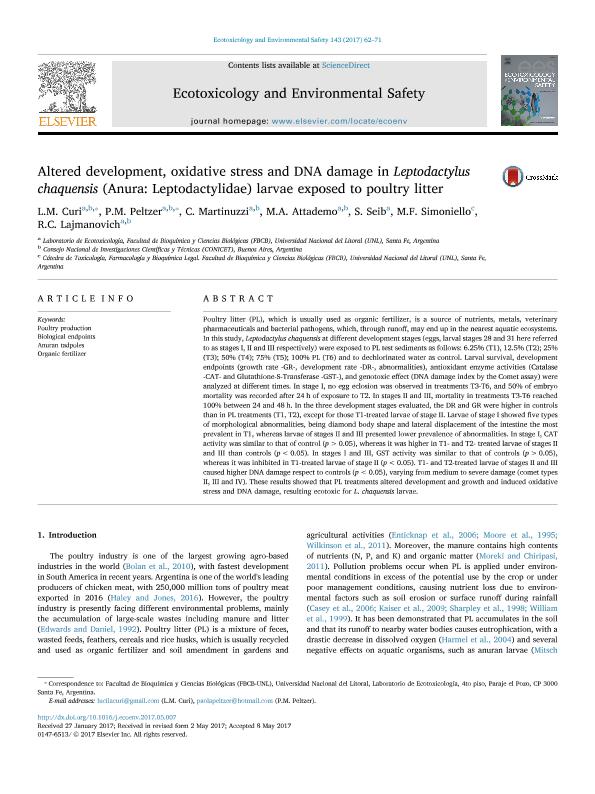Mostrar el registro sencillo del ítem
dc.contributor.author
Curi, Lucila Marilén

dc.contributor.author
Peltzer, Paola

dc.contributor.author
Martinuzzi, Candela Soledad

dc.contributor.author
Attademo, Andres Maximiliano

dc.contributor.author
Seib, S.
dc.contributor.author
Simoniello, Maria Fernanda

dc.contributor.author
Lajmanovich, Rafael Carlos

dc.date.available
2018-04-17T16:58:00Z
dc.date.issued
2017-09
dc.identifier.citation
Curi, Lucila Marilén; Peltzer, Paola; Martinuzzi, Candela Soledad; Attademo, Andres Maximiliano; Seib, S.; et al.; Altered development, oxidative stress and DNA damage in Leptodactylus chaquensis (Anura: Leptodactylidae) larvae exposed to poultry litter; Academic Press Inc Elsevier Science; Ecotoxicology and Environmental Safety; 143; 9-2017; 62-71
dc.identifier.issn
0147-6513
dc.identifier.uri
http://hdl.handle.net/11336/42276
dc.description.abstract
Poultry litter (PL), which is usually used as organic fertilizer, is a source of nutrients, metals, veterinary pharmaceuticals and bacterial pathogens, which, through runoff, may end up in the nearest aquatic ecosystems. In this study, Leptodactylus chaquensis at different development stages (eggs, larval stages 28 and 31 here referred to as stages I, II and III respectively) were exposed to PL test sediments as follows: 6.25% (T1), 12.5% (T2); 25% (T3); 50% (T4); 75% (T5); 100% PL (T6) and to dechlorinated water as control. Larval survival, development endpoints (growth rate -GR-, development rate -DR-, abnormalities), antioxidant enzyme activities (Catalase -CAT- and Glutathione-S-Transferase -GST-), and genotoxic effect (DNA damage index by the Comet assay) were analyzed at different times. In stage I, no egg eclosion was observed in treatments T3-T6, and 50% of embryo mortality was recorded after 24 h of exposure to T2. In stages II and III, mortality in treatments T3-T6 reached 100% between 24 and 48 h. In the three development stages evaluated, the DR and GR were higher in controls than in PL treatments (T1, T2), except for those T1-treated larvae of stage II. Larvae of stage I showed five types of morphological abnormalities, being diamond body shape and lateral displacement of the intestine the most prevalent in T1, whereas larvae of stages II and III presented lower prevalence of abnormalities. In stage I, CAT activity was similar to that of control (p>0.05), whereas it was higher in T1- and T2- treated larvae of stages II and III than controls (p<0.05). In stages I and III, GST activity was similar to that of controls (p>0.05), whereas it was inhibited in T1-treated larvae of stage II (p<0.05). T1- and T2-treated larvae of stages II and III caused higher DNA damage respect to controls (p<0.05), varying from medium to severe damage (comet types II, III and IV). These results showed that PL treatments altered development and growth and induced oxidative stress and DNA damage, resulting ecotoxic for L. chaquensis larvae.
dc.format
application/pdf
dc.language.iso
eng
dc.publisher
Academic Press Inc Elsevier Science

dc.rights
info:eu-repo/semantics/openAccess
dc.rights.uri
https://creativecommons.org/licenses/by-nc-nd/2.5/ar/
dc.subject
Poultry Production
dc.subject
Biological Endpoints
dc.subject
Anuran Tadpoles
dc.subject
Organic Fertilizer
dc.subject.classification
Otras Ciencias Biológicas

dc.subject.classification
Ciencias Biológicas

dc.subject.classification
CIENCIAS NATURALES Y EXACTAS

dc.title
Altered development, oxidative stress and DNA damage in Leptodactylus chaquensis (Anura: Leptodactylidae) larvae exposed to poultry litter
dc.type
info:eu-repo/semantics/article
dc.type
info:ar-repo/semantics/artículo
dc.type
info:eu-repo/semantics/publishedVersion
dc.date.updated
2018-04-04T14:43:05Z
dc.journal.volume
143
dc.journal.pagination
62-71
dc.journal.pais
Países Bajos

dc.journal.ciudad
Amsterdam
dc.description.fil
Fil: Curi, Lucila Marilén. Universidad Nacional del Litoral. Facultad de Bioquímica y Ciencias Biológicas. Laboratorio de Saneamiento Ambiental. Cátedra de Ecotoxicología; Argentina. Consejo Nacional de Investigaciones Científicas y Técnicas; Argentina
dc.description.fil
Fil: Peltzer, Paola. Universidad Nacional del Litoral. Facultad de Bioquímica y Ciencias Biológicas. Laboratorio de Saneamiento Ambiental. Cátedra de Ecotoxicología; Argentina
dc.description.fil
Fil: Martinuzzi, Candela Soledad. Consejo Nacional de Investigaciones Científicas y Técnicas; Argentina. Universidad Nacional del Litoral. Facultad de Bioquímica y Ciencias Biológicas. Laboratorio de Saneamiento Ambiental. Cátedra de Ecotoxicología; Argentina
dc.description.fil
Fil: Attademo, Andres Maximiliano. Universidad Nacional del Litoral. Facultad de Bioquímica y Ciencias Biológicas. Laboratorio de Saneamiento Ambiental. Cátedra de Ecotoxicología; Argentina
dc.description.fil
Fil: Seib, S.. Universidad Nacional del Litoral. Facultad de Bioquímica y Ciencias Biológicas. Laboratorio de Saneamiento Ambiental. Cátedra de Ecotoxicología; Argentina
dc.description.fil
Fil: Simoniello, Maria Fernanda. Universidad Nacional del Litoral. Facultad de Bioquímica y Ciencias Biológicas. Laboratorio de Saneamiento Ambiental. Cátedra de Ecotoxicología; Argentina
dc.description.fil
Fil: Lajmanovich, Rafael Carlos. Consejo Nacional de Investigaciones Científicas y Técnicas; Argentina. Universidad Nacional del Litoral. Facultad de Bioquímica y Ciencias Biológicas. Laboratorio de Saneamiento Ambiental. Cátedra de Ecotoxicología; Argentina
dc.journal.title
Ecotoxicology and Environmental Safety

dc.relation.alternativeid
info:eu-repo/semantics/altIdentifier/url/https://www.sciencedirect.com/science/article/pii/S0147651317302804
dc.relation.alternativeid
info:eu-repo/semantics/altIdentifier/doi/http://dx.doi.org/10.1016/j.ecoenv.2017.05.007
Archivos asociados
